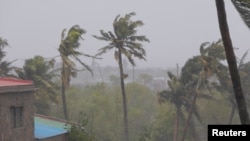The storm trackers, launched from New Zealand's Mahia Peninsula early Friday, completed the TROPICS constellation of shoebox-sized satellites.
They can fly over hurricanes (or typhoons in the Pacific) every hour, compared to every six hours with current satellites.
The information gathered on rainfall, temperature and humidity could help scientists determine where a hurricane will make landfall and how intense it will be, helping people living in coastal areas be better prepared for possible evacuations.
In the long term, a better understanding of the formation and evolution of these storms could help improve climate models.
"As a lifelong Floridian, I know firsthand how critical it is for millions of Americans to have timely and accurate forecasts for hurricanes," NASA administrator Bill Nelson said in a statement.
"More intense rainfall and increased coastal flooding are devastating livelihoods and taking lives, demonstrating the importance of NASA's cutting-edge science to help answer questions that nobody else can."
The first pair of satellites were launched successfully earlier this month.
The constellation was originally intended to have six satellites, not four, but the first two were lost when a U.S. Astra rocket malfunctioned shortly after lift-off last year.
Hurricanes, or typhoons, are becoming more powerful as the ocean surface warms, scientists say.
Hurricane Ian, which devastated Florida in 2022, killed dozens of people and caused more than $100 billion in damage, making it by far the world's most expensive weather disaster of the year.
The U.S. National Oceanic and Atmospheric Administration on Thursday predicted a "near normal" hurricane season with 12 to 17 named storms packing winds of at least 63 kph.
After three seasons with an atmospheric phenomenon called La Nina, which worsens hurricanes in the Atlantic, NOAA predicts an El Nino to develop this summer, which has a suppressive effect on hurricane activity.
But this could be offset by more localized conditions favorable for hurricanes, such as an above-normal west African monsoon, "which produces African easterly waves and seeds some of the stronger and longer-lived Atlantic storms," NOAA said.

Forum